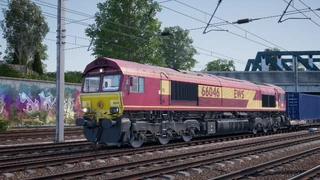The BR Class 66 is a modern UK freight locomotive operated by most UK freight operators.
In Train Sim World, the BR Class 66 is featured in the Great Western Express add-on in DB Schenker livery. The locomotive has a maximum speed of 75 mph and a total of 455 of the class were produced, making it one of the most numerous locomotives in the UK.
About
Derived from the Class 59, the British Rail Class 66 is one of Britain's most powerful freight locomotives and can be seen virtually every corner of the country on a variety of services from rescue to heavy freight. Lovingly nicknamed 'Sheds', owing to their shed-like roof profile, they have more than proved themselves on British railways due to their impressive reliability and versatility.
History
In 1996, the privatisation of British Rail reached freight operations, and the previously grouped divisions such as Mainline Freight, Load-Haul and Trans-Rail were due to be sold to new private owners. Wisconsin Central Transportation Systems opted to buy a majority of the divisions in one go, quickly taking charge of no less than 93% of UK rail freight operations. After consulting with the public, the new freight operating company (FOC) was named English Welsh & Scottish.
Naturally, by taking over such a significant portion of operations, EWS inherited a lot of locomotives, many of which were, at least from their point of view, ageing and proving expensive with more frequent maintenance. EWS sought to introduce a new freight locomotive for the UK, one that would be more powerful, more reliable, and more cost effective; they turned to an already-in-service design, the Class 59, as the basis for their new fleet.
EMD designed the Class 59 in the 1980s as a UK-compatible derivative of the SD40-2, and despite a handful only being built, the private companies that owned them were impressed with their powerful performance. EWS approached EMD about ordering a new fleet, and EMD offered an upgraded iteration of the Class 59; same bodyshell, but different engines and traction motors, plus the addition of self-steering bogies to reduce wear.
EWS were impressed, and ordered 250 locomotives which were to be built in London, Ontario, Canada. Initially, the new fleet were to be classified as the BR Class 61 under TOPS, but this was later changed to Class 66. The first Class 66 arrived on UK soil in June 1998, and deliveries continued consistently until December 2001.
The Class 66 fleet proved to be a success, EWS owned such a majority of the freight market that the new locomotives could be seen practically anywhere, on everything from spoils trains to container freight, aggregate duties and engineering works. As they were the prime culprit, in many enthusiasts’ eyes, for the withdrawal of countless British-built locomotives, the Class 66 became known as “The Red Death”, however they were warmed to enough at least to warrant a nickname, the “Shed”, owing to their shed-like roof profile. Nevertheless, the Class 66’s reliability and versatility has been key to a competitive rail freight market.
Freightliner, GB Railfreight and Direct Rail Services would also go on to ordering the Class 66 in bulk from the late 1990s to 2015, by which point stringent emission regulations put a cap on the class, and the final locomotive, 66 779, was delivered in February 2016 and named ‘Evening Star’, sporting a nostalgic BR Green livery. Despite the last being built however, a total of 455 Class 66 locomotives have been delivered to the UK over the past 19 years; a resounding achievement for rail freight operations in the UK.
The EWS-bound Class 66 fleet was first seen of course in the Red and Yellow EWS livery, with the stylistic “Beasties” logo depicting the heads of a lion (England), dragon (Wales) and stag (Scotland). In 2007, Deutsche Bahn purchased EWS and assumed control of all operations. DB stated that they would not rebrand EWS, but that changed in 2009 when a Class 59 was unveiled with DB Schenker branding and a new bright red livery. Today, many Class 66 locomotives adorn the striking new coat of paint, and despite DB Schenker itself being rebranded as DB Cargo Rail UK in 2016, only a handful of locomotives have received a logo change so far.
Operators
DB Cargo UK
The BR Class 66 was originally only available in the DB Schenker livery, now superseded by DB Cargo UK. This version is included in the Great Western Express package.
EWS
On the 24th October 2017, an EWS livery was added to the Class 66. These locomotives are operated by DB Cargo UK but have not yet been repainted into newer liveries. All class 66 services can be operated with either livery.
Starting the Locomotive
1. Enter the leading cab
2. The Master Key of the Class 66 is in fact the reverser lever itself, it can only be inserted or removed when the handle is in the neutral position. To insert the Master Key click on the reverser control housing (the part that the handle is inserted to).
3. The brake control on the Class 66 is a Proportional control. This means you apply and release the brake by adding or removing air in the system. Moving Automatic Brake handle forward applies the brake, moving it backward, releases the brake. Press and hold the Automatic Brake control forward until the Brake Pipe Control gauge reads 3.4 bar.
4. If the Parking Brake is applied, denoted by the Dowty indicator on the control desk, press the button to release it
5. Press the Engine Start button to start the engine.
6. The train starts with all safety systems disabled, to activate them, locate the controls in the right-most cabinet behind the driving position. The train is fitted with Automatic Warning System (AWS), Train Protection and Warning System (TPWS) and Driver Vigilance Device (DSD). The relevant controls will therefore become enabled upon activating the system.
7. On enabling the AWS system, this will also enable the TPWS system as both systems are interlinked. A self-test will commence and you will need to acknowledge the alert to proceed. Press the Q key on your keyboard to do so.
8. On enabling the DSD system, you will hear an alert periodically that you will need to acknowledge using the Q key. If you do not react quickly enough, the train will commence an emergency brake application.
9. Set your headlights to the correct running mode, Day Mode during daylight hours from 8am until 8pm; Night Mode during twilight and evening hours from 8pm to 8am or where it is necessary to improve visibility for users of the railway and trackside signage.
10. Ensure all cab doors are closed, including the rear cab.
11. To move your train, simply move the reverser to the forward position, release the brake by moving the Automatic Brake control backward until the Brake Pipe Control gauge reads 5 bar. Move the power controller to notch 1. As the train begins to move, you can then select any other power notch, ensuring you do not exceed the Maximum Permitted Speed.
| Great Western Express | |
|---|---|
| Locomotives | BR Class 43 HST - BR Class 66 - BR Class 166 |
| Rolling Stock | BR Mk3 - HKA Hopper - FKA Container Flat |
| Stations | London Paddington - Acton Main Line - Ealing Broadway - West Ealing - Hanwell - Southall - Hayes & Harlington - West Drayton - Iver - Langley - Slough - Burnham - Taplow - Maidenhead - Twyford - Reading |
| Other Locations | Old Oak Common TMD - Airport Junction |
| Operators | Great Western Railway - DB Cargo UK |
| Tutorials | Class 43 Introduction - Class 166 Introduction - Class 66 Introduction - Station Stopping |
| Scenarios | Down the Line - West World - Christmas Closures - Aggregate Industries - Drag Line |
| Journeys | Commuter Driver - Express Driver - Freight Driver - Mainline Driver |
| Guides | Driving the BR Class 66 - Driving the BR Class 43 - Driving the BR Class 166 - Collectibles |
| Miscellaneous | Signalling - Service Timetable |
| DLC | Diesel Legends of the Great Western - Cargo Line: Petroleum - Cargo Line: Aggregates |
